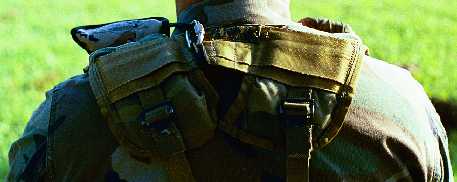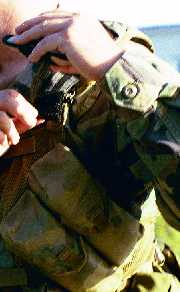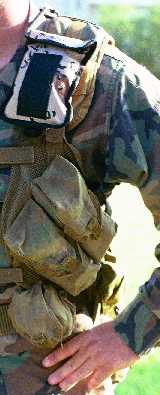
Combat Life Saver: the Army needs to honor this training with better equipment and insignia
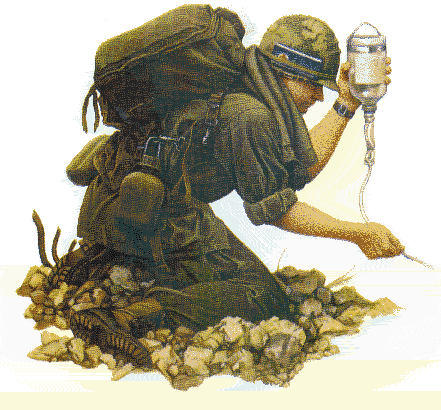
199th Infantry Brigade Medic in Vietnam, note M5 Aid bag on his back and no red cross arm band
A Vietnam combat veteran writes:
"I know for a fact that to the North Koreans a red cross just made a good aiming point. I couldn't swear to that about the Chinese.I knew a medic Spec 7 (don't believe the rank exists anymore) who had a CMB with a star, indicating both WW2 and Korean service. He also had a couple of other personal decorations. Suffice it to say, he had seen it. He wasn't one to talk about his combat experience but one day I pressed him for details about the differences between WW2 and Korea. In 3 years in WW2 against the Germans, he had to duck mortars and artillery but never had to worry about rifle or machine gun fire. He had heard that some SS units fired on the red cross but it had never happened to him. He also knew of Americans who fired on the red cross but they were not regarded well by their comrades.
When he went to Korea, early in the war, for the first time he experienced machine gun and rifle bullets pinging and richocheting around him. It shocked him that he was being targeted. They issued the medics carbines to protect them from snakes. Paul never worked against Chinese so he did not know their attitude towards the red cross. But as a general statement North Koreans were far more brutal than the Chinese, for example, in the handling of POWs; therefore it is possible the Chinese observed the red cross.
U.S. Army Center for Lessons Learned: Operation Just Cause Medical concludes:
"Paramilitary forces, such as DIGBATs and PDF deserters, did not recognize the red crosses on ambulances. Evacuation vehicles/aircraft should be escorted whenever possible. "
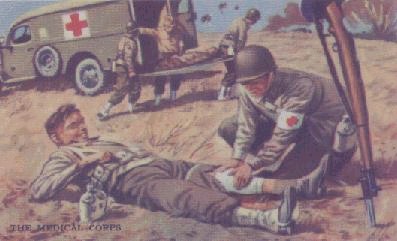
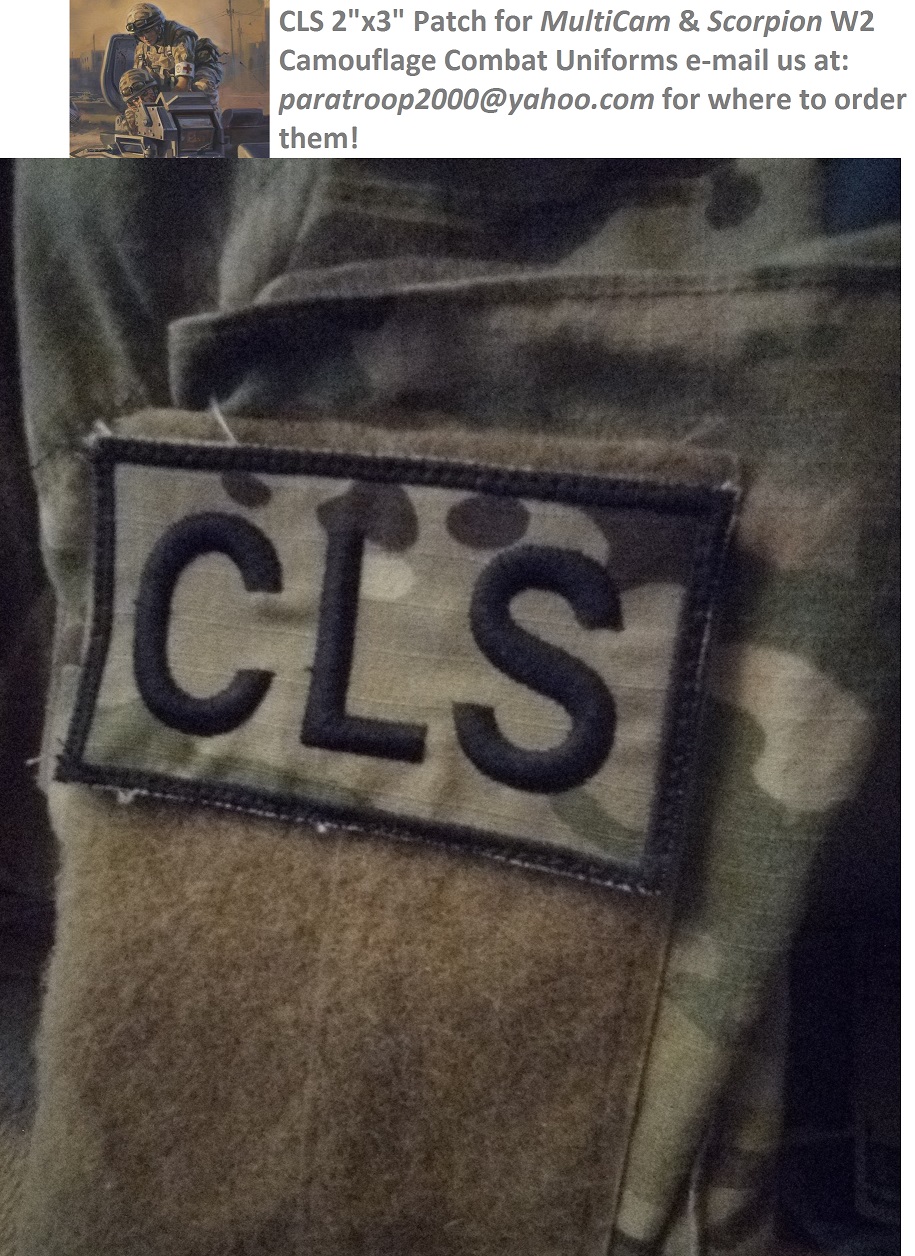
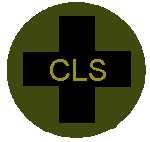
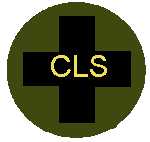
THE FORT BRAGG POST
Getting first aid to wounded Soldiers has always been dangerous, since it is danger that got the Soldier hurt in the first place. The 91B/91W Aidman attached to every infantry platoon is a very over-worked person who may be targeted by an unethical enemy wearing the proper red cross arm band. The U.S. Army's Combat LifeSaver (CLS) Program is an excellent initiative to get a Soldier in every squad-sized unit skilled and equipped to perform emergency life saving medical tasks; like starting I.V.'s.
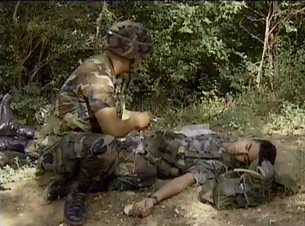
CLSers are to bridge the gap from self-aid or buddy aid (SABA) training every Soldier receives and the platoon Aidman (91B/91W Combat medic). The fluid, non-linear battlefield requires that injured Soldiers get treated immediately and their condition stabilized, not wait for another level of care to treat them which is often too late.
U.S. Army Center for Lessons Learned: Operation Just Cause Medical says the following about CLSers in Panama combat:
"Commanders are convinced that the Combat LifeSavers saved lives and directly contributed to accomplishing the mission."
•"Combat LifeSavers carrying intravenous (IV) fluid and starter sets are critical in preventing heat injuries from becoming debilitating. They know the importance of securing the objective first and then treating the casualty as well as the limits of their medical capability."
"Troopers from the 82nd Airborne Division consumed both canteens of water on their long flight to Panama and were unable to replenish them before they jumped. Once they jumped, it took the dispersed units up to two hours to get to their rally points, and due to the tropic heat, the troops arrived completely wet with sweat. Several Soldiers became dehydrated and suffered heat injuries. The Combat LifeSavers were able to treat them immediately and probably saved many lives."
Mechanized Infantry attack in the Gulf war: Soldier saved by medical care:
http://emergency.com/cmbtmedc.htm
HOW TO GET CLS QUALIFIED.....
Fayetteville Technical Community College (FTCC) runs CLS class at its spring Lake facility a short distance away from Fort Bragg, NC. Call Retired combat medic Command Sergeant Major Jim Messenger, head ELS/CLS instructor at (910) 308-0406 and make arrangements for you to attend ELS/CLS certification training through FTCC. The two-week course has students receiving much more
hands-on training on treating injuries than just those that are taught from classrioom instruction! ELS/CLS also teaches much more than the IPD requirements for CLS certification.
Enrollment is simple. All anyone interested in attending has to do is contact CSM Jim Messenger!
Fee for the course is just $50 [in groups of 11 students or more, he is allowed to reduce the fee to $35 per student]
Individuals may pay for themselves, or military units may pay for their Soldiers to attend; this is usually accomplished using the IMPAC credit card.
Classes are during duty hours 0730-1630 Monday thru Friday. Classes scheduled for the remainder of this CY are as follow:
3-13 September
16-27 September
30 Sep-11 October
14-25 October
28 Oct-8 November
11-22 November
2-13 December
If you are not in the local Ft. Bragg area, you can enroll your Soldiers in a group study, receiving CLS study materials from the U.S. Army Institute for Professional Development (AIPD).
USA AIPD
ATTN: ATIC IPS
U.S. Army Training Support Center
Newport News, Va 23628-0001
http://155.217.35.238/accp/accp_top.htm
2.61.A General information.
a. General information.
(1) The Combat Lifesaver Correspondence Course is available through group enrollment. To establish this group enrollment, AIPD must receive the following:
(a) A cover letter signed by the battalion commander or a lieutenant colonel or higher. The cover letter should identify the primary instructor (group leader). All instructors of the Combat Lifesaver Course must meet the following criteria: either hold primary MOS 91B, 91C, 18D, or be a licensed paramedic (state or national), registered nurse, physician assistant or physician. These requirements reflect the level of expertise necessary to resolve medical emergencies associated with the tasks taught.
(b) One DA Form 145 enrolling the primary instructor in IS0826, along with a list of assistant instructors, if any. Include the instructor's and assistant instructors' RYE date, if applicable. The DA Form 145 should be signed by a responsible official who has the authority to requisition or acquire the necessary medical supplies to support this training.
(c) A roster of students enrolling in IS 0824 and IS 0825. The roster must include each student's full name, rank, SSN, component code, and RYE date, if applicable. Ideally, no more than 15 to 20 students should be assigned to each group.
(2) Once the group enrollment processes, if a student is unable to attend class, but can be rescheduled within 1 year, his or her enrollment should not be canceled. The instructor should keep all the material for the student until he or she can attend the class. For students who cannot be rescheduled, a request must be submitted to cancel their enrollment. The group leader may cancel an enrollment by writing 'CANCEL' across the student's scan sheet and returning it to AIPD or send a memo identifying which student enrollments should be cancelled. Group leaders must also ensure that Soldiers completing this training promptly receive their completion notices (ATSC Form 157). For further information on group study, see paragraph 1-7b.
(3) When contacting AIPD, you must provide the group enrollment number that is found on your enrollment notice, ATSC Form 157.
2.61.B Objective.
b. Objective. To provide the training required for a Soldier to be awarded the combat lifesaver designation.
2.61.C Eligibility.
c. Eligibility. Students will be selected by their unit to attend the group study program.
2.61.D Curriculum.
d. Curriculum. 2 subcourses (shipped in one box), 40 credit hours.
(1) Includes self-study materials and approximately 3 days of classroom instruction and testing. Testing includes both proctored multiple-choice and performance examinations. Only one examination response sheet (IS0827) is returned to AIPD for grading upon completion of IS0824 and IS0825. This is a GO or NO/GO course.
(2) Subcourses. IS0824, IS0825. (IS0826 is only available to the instructor and assistant instructors.)
2.61.E Recertification.
e. Recertification. Do not reenroll Soldiers requiring recertification. This can be accomplished by unit instructors. The instructor guide includes a test appropriate to recertification.
2.61.F Additional information.
f. Additional information. For additional information, write to Student Services Division at the Army Institute for Professional Development, U.S. Army Training Support Center, Newport News, VA 23628-0001, or call DSN 927-3322/2127 or commercial 757-878-3322/2127.
CLS is managed by the U.S. Army Medical Command based at Fort Sam Houston, TX.
USA Medical Department Center and School
ATTN: MCCS-HTI (SFC Ira Williams)
Commandant AHS
1750 Greeley Road Bdg 4011
Ft. Sam Houston, TX 78234-6122
DSN 429-8516/471-0275 or:
COM (210) 916-8516/221-0275
COMPUTER CLS TRAINING: THE CD
The AMEDDC&S, Army Research Institute, Pennsylvania National Guard and National Guard Bureau (NGB) has developed an interactive CD-ROM (CD 8-01, Combat Lifesaver: Medical Tasks) to be used as sustainment training for those tasks described in the AIPD course IS O825 (Combat Lifesaver Course: Medical Tasks). This CD-ROM has been distributed by the Army Training Support Center and is available through your local Training Support Center (TSC) or Visual Information Support Center (VISC) or by sending an e-mail message to Don Atkerson don.atkerson@cs.amedd.army.mil, or Ms. Shirley Castonquay: castonqs@atsc.army.mil
Other www sites with info on the superb CLS CD:
www.cs.amedd.army.mil
http://ae2178.med.osd.mil
http://atscweb.atsc-army.org/accp/ix.htm
CPR TRAINING
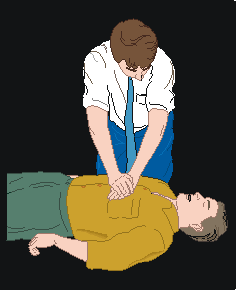
One of the skills of the CLS is Cardio-Pulminary Resuscitation or CPR. An excellent web site with resources that can be obtained like inexpensive practice mannequins:
CLS SUPPLIES
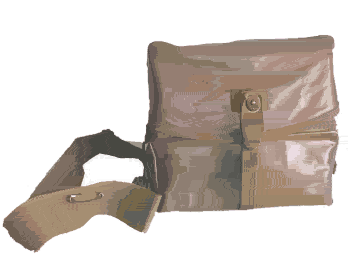
The Key medical supplies for the Combat LifeSaver are held in the M3 bag, contents list available on the link here. M3 Combat Life Saver bag list
Being a Combat LifeSaver is more than an U.S. Army completion certificate, 40 credit hours and 8 promotion points, it's an important responsibility with skills that are perishable that need to be re-certified every 12 months.
WHO IS WHO? "MEDIC!"..."COMBAT LIFE SAVER!"
 www.youtube.com/watch?v=vZ1w4mmVZ40
www.youtube.com/watch?v=vZ1w4mmVZ40
But how can you tell who is a Combat LifeSaver or any combat medical Soldier/Paratrooper (18D SF Medical Sergeant or 91B Aidman) unless they have an EFMB (Expert Field Medical Badge) or CFMB (Combat Field Medical Badge)? What do you do if the E/CFMB is covered by flak jacket/body armor (as it should for ballistic protection)? What we need is a subdued Universal Combat Medical Identifier (UCMI) that would be worn on the shoulder sleeve to speed identification of medical care providers in our units. A sample pair of designs are depicted at the top of this web page..
With an UCMI, unit officials will know at a glance who the Combat LifeSavers are in their units and to structure training and insure they carry their M3 bags to the field and on ruck marches or unit PT formations, so we are ready to give fast and efficient medical care if it's needed. This identifier builds spirit and isn't a flimsy pin-on arm band that gets snagged or caught on vehicle edges or vegetation...or gets you shot. If the red arm band has to come off there is still some form of insignia to protect medical personnel in event they are targeted by a sniper or captured.
The 91B/91W and 18D Medics also need some form of subdued arm sleeve identification. By placing the word "Medic" in the center of our patch depicted here, we now have an identifier for these Soldiers. This patch would not replace the full color red and white arm bands but provide at least some identification if these are unavailable.
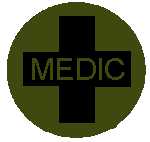
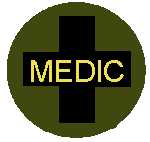
The patches would also be a small metal skill badge for wear on the Class "A" uniform possibly looking like the candidate badges below:
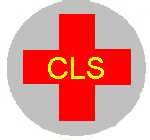
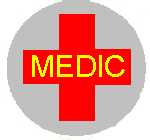
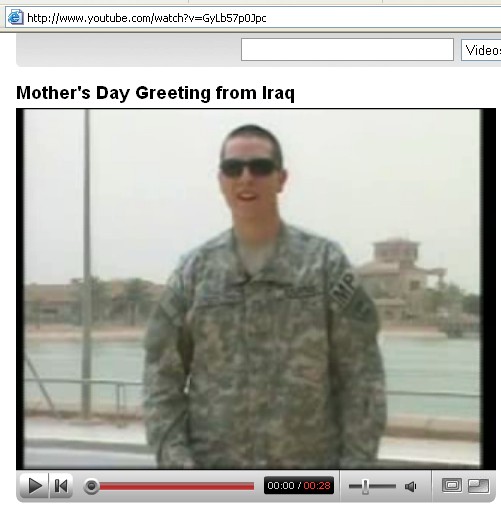
The problem is this preponderance of velcro wears out in continued field use and launderings and needs to be covered up. The CLS insignia can help solve this by covering over the top left pocket's flap like the U.S. flag does on the right sleeve's pocket.
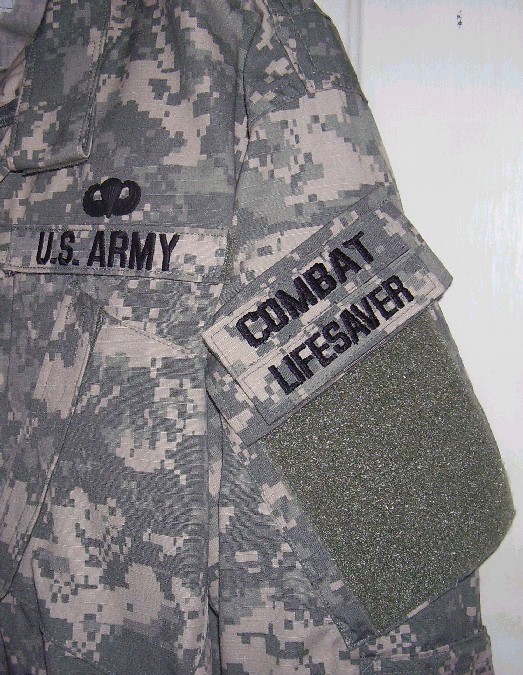
The distinctive CLS insignia was created by making two ACU nametapes one saying "COMBAT" and the other "LIFESAVER" and sewing them onto a pocket top flap ACU cover kit blank patch offered by Ranger Joe's in Columbus, Georgia.
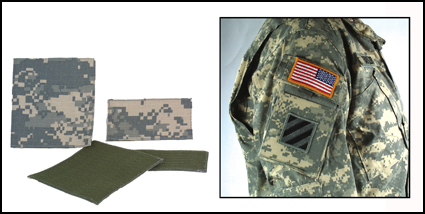
ACU Digital Patch Cover Up Kit
[A1551] $12.95
Protect the exposed loop fastener on your uniform sleeves with this cover up kit. 4" x 4.75" patch covers the loop fastener on the shirt sleeve pockets and the 2" x 4" patch covers the loop fastener on the shirt sleeve pocket flaps. Includes 2 of each size patch.
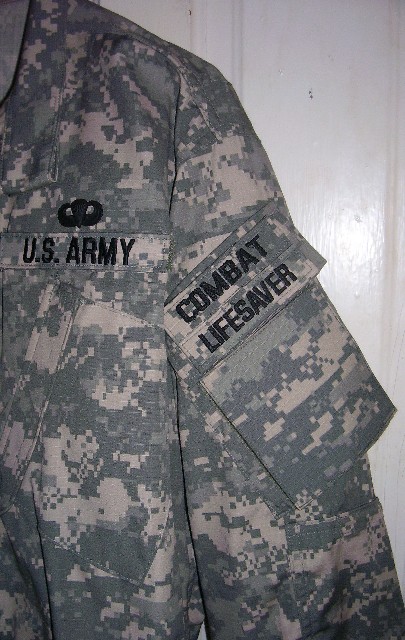
Each ACU pocket cover-up kit comes with 2 small and two large pocket velcro covers and thus, can create two CLS insignias and fully cover the velcro of one Soldier's ACU. He should sew his unit and/or combat patches to the large ACU cover patch.
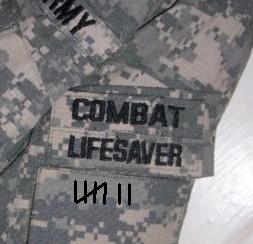
Another possibility is that as a Medic or CLS saves lives he can mark off these successes on the blank ACU material like football players will put stickers on their helmets for tackles and touchdowns. If HQDA were to adopt the CLS insignia as uniform SOP, these could be created by any off-post sewing establishment though a specially embroidered pocket flap cover with "COMBAT LIFESAVER" would be thinner and require less sewing.
GETTING SUCH A PATCH/BADGE IDENTIFIER IS NOT EASY.
The U.S. Army Institute of Heraldry will not act until DA approves the general idea. They won't budge until a major command asks for it. You, the reader, can help the cause by becoming a CLS, getting your M3 bag and writing to the U.S. Army Chief of Staff and asking that an U.S. Army think-tank be formed to gather like ideas from the troops and act on them without having to go through multiple layers of hostile bureaucracy.
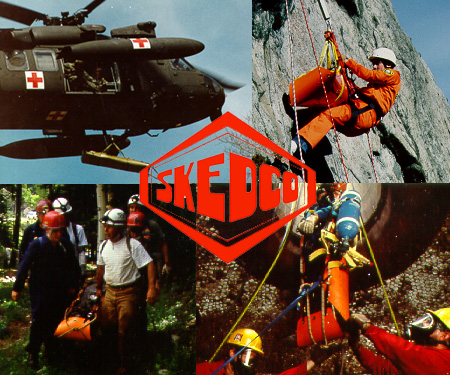
BETTER MEDEVAC TOOLS AVAILABLE....
SKEDCO

SKEDCO in action in Afghanistan combat!
During the medical evacuation portion of CLS, the curriculem should be upgraded to include the amazing SKEDCO lightweight rescue system and the new all-terrain cart system already in U.S. Army service. This way, the squad's CLS will be the Subject-Matter-Expert (SME) on these devices so they get used to the fullest.
Medical Evacuation And Training During Ranger School: the role of the SKED
U.S. Army Infantry Magazine, January-February 2002
1/187th Infantry, 101st AASLT Division 1LT Robert Thompson on page 5 of the June-April '99 Infantry magazine proposes SKEDCOs be used to slide tripod-mounted, M2 .50 cal and MK-19 40mm heavy machine guns from helicopters to provide superior firepower for Air Assault units.
http://192.153.150.25/catd/Infantry%20Magazine/Issues/1999%20JAN-APR%20Issue%201/Swap%20Shop.pdf
SKEDCOs in action hauling ammo in combat in Afghanistan:
The Corporal Desmond T. Doss HALF-SKEDCO M3A "Alpha model" and Captain Ernie Blanco II Airborne Operations CLS Assault Packs
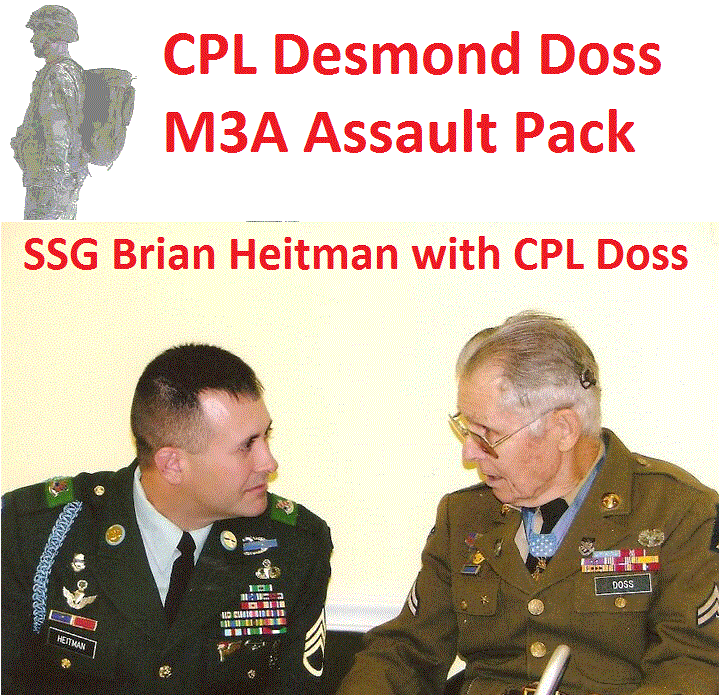
A half-SKED "M3A" CLS assault pack has outer pouches to hold all the M3 bag contents as well as items needed in an assault along with a lightweight half-sized SKEDCO sliding plastic sheet so each CLS in every rifle squad has a means to evac his casualty out of the line-of-fire (the Kosmo rescue line comes in here, too)....and after the firefight is over, slide him to the Platoon Casualty Collection Point (CCP)...
Pringle Combat LifeSaver & Medical Assault Vest
Have your medical supplies at the ready on your chest as you render life-saving first aid!
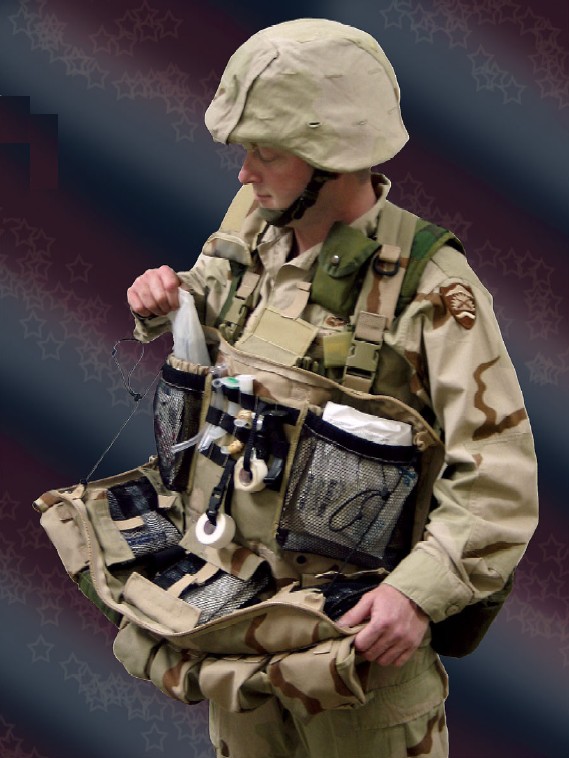
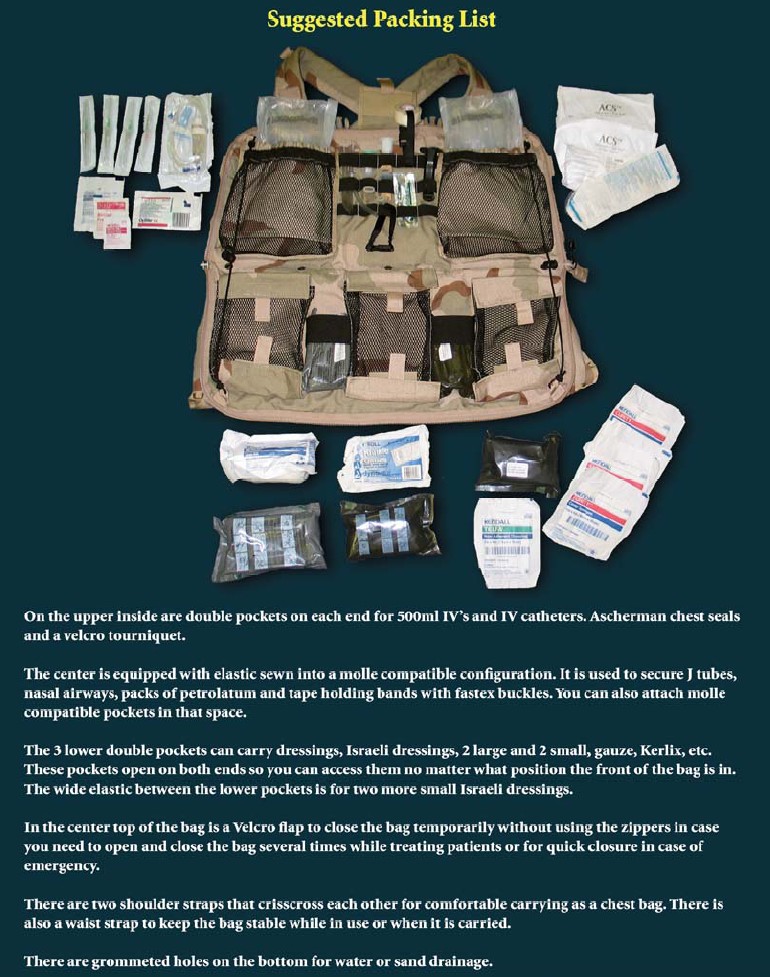
http://www.skedco.com/detail.aspx?categoryID=2&subID=11&sku=SK-1120
PRINGLE "Workhorse"(TM) Combat Lifesaver's Bag
NSN: 6545-01-527-9873
SK-1120-XX
Product Brochure
www.skedco.com/documents/Chest_Bag_Brochure.pdf
This unique medical bag is worn on the chest however there are buckles on the back that match up with assault vests, etc, so it can also be worn as a butt pack.
There are 6 pockets that can be removed and replaced with saw pouches or any other molle compatible pockets. You can carry more medical gear or ammo, a weapon, or other useful items outside the bag.
On the back side of the bag, against your chest is a long pocket for 1-2 Sam Splints and a book of field medical cards. Inside that pocket is another pocket for extra rubber gloves.
There are straps to secure long items on the underside of the bag.
On the upper inside are double pockets on each end for 500ml IV's and IV catheters. Asherman chest seals and a velcro tourniquet.
The center is equipped with elastic sewn into a molle compatible configuration. It is used to secure J tubes, nasal airways packs of petrolatum and tape holding bands with fastex buckles. You can also attach molle compatible pockets in that space.
The 3 lower double pockets can carry dressings, Israeli dressings, 2 large and 2 small, gauze, Kerlix, etc. These pockets open on both ends so you can access them no matter what position the front of the bag is in. The wide elastic between the lower pockets is for two more small Israeli dressings.
In the center top of the bag is a Velcro flap to close the bag temporarily without using the zippers in case you need to open and close the bag several times while treating patients or for quick closure in case of emergency.
There are two shoulder straps that crisscross each other for comfortable carrying as a chest bag. There is also a waist strap to keep the bag stable while in use or when it is carried.
There are drain holes for water or sand drainage.
1" fastex buckles allow use as a butt pack.
This bag is available without external front pockets.
Holster is not included.
Available in ACU, DC, Coyote Brown, OD and Black. Made in USA.
Catalog # Description Weight MSRP
SK-1120-XX PRINGLE "Workhorse"(tm) Combat Lifesaver's Bag 4 lbs $271.21
Please contact Skedco for government pricing
Essential Items for Inside your CLS Assault Pack and/or Pringle Assault/Medical Vest
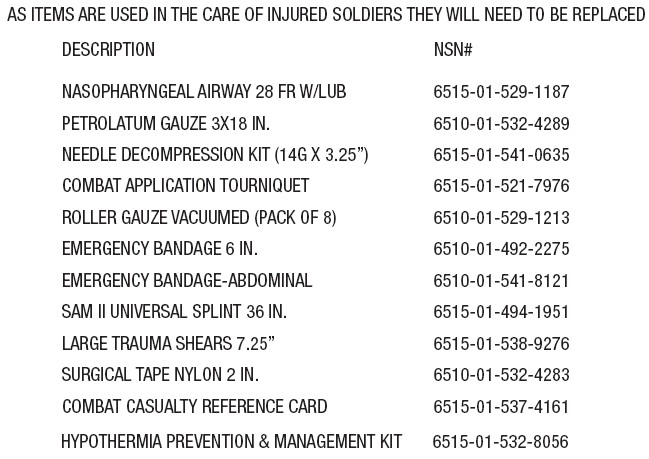
GAIN CONTROL OF THE SITUATION
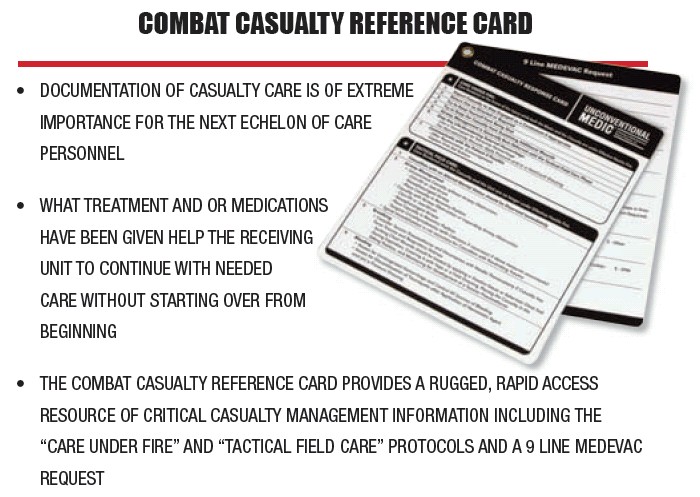
STOP THE BLEEDING

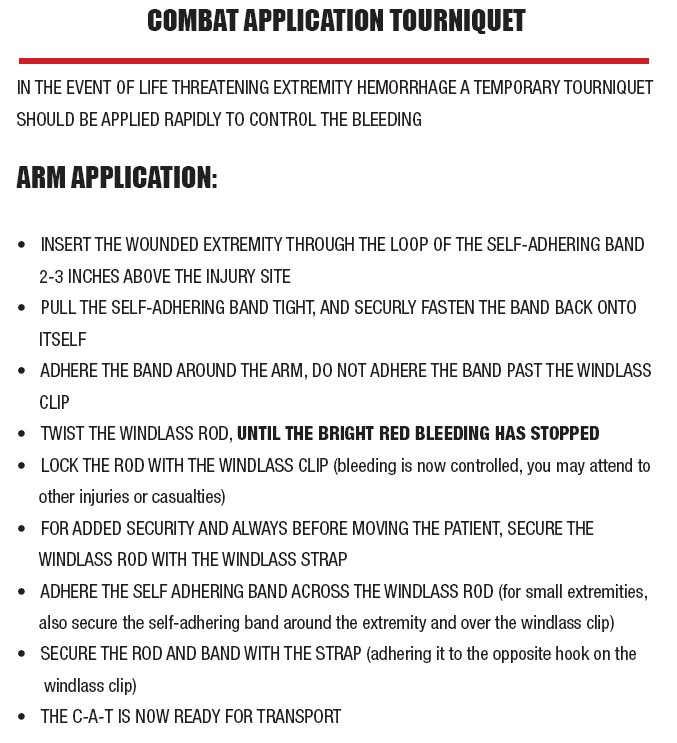
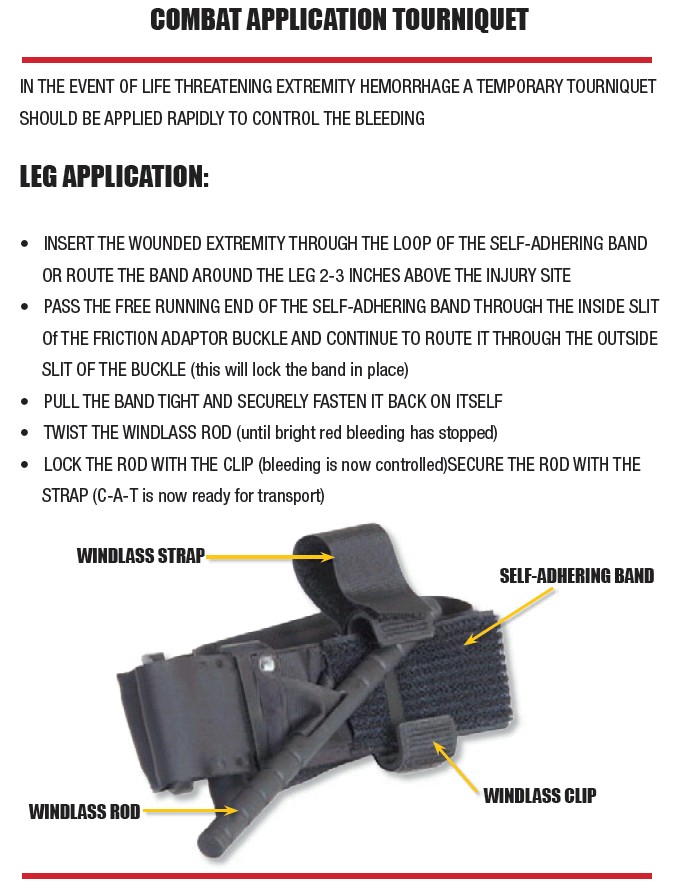
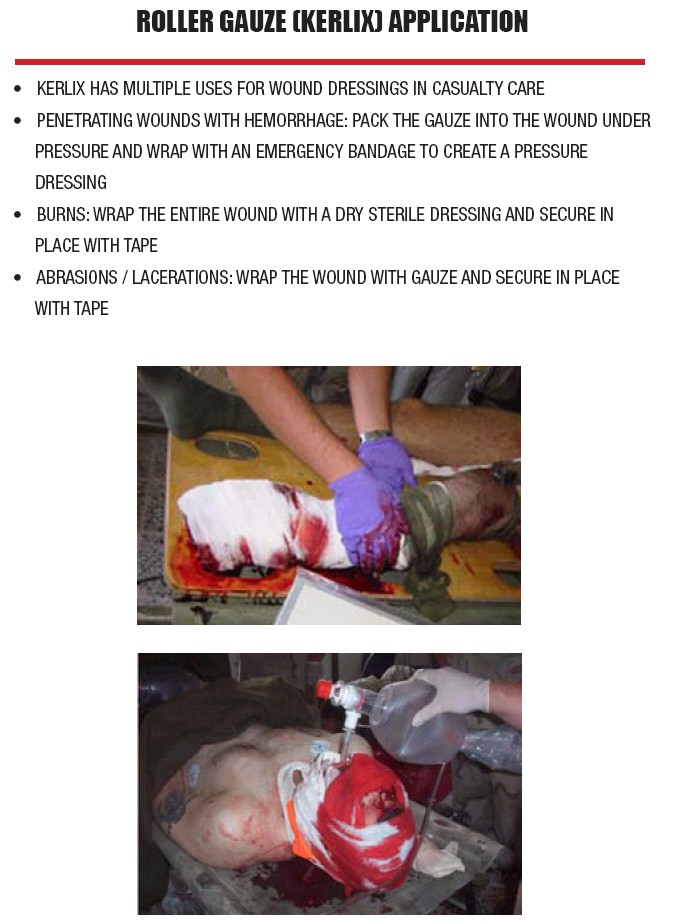
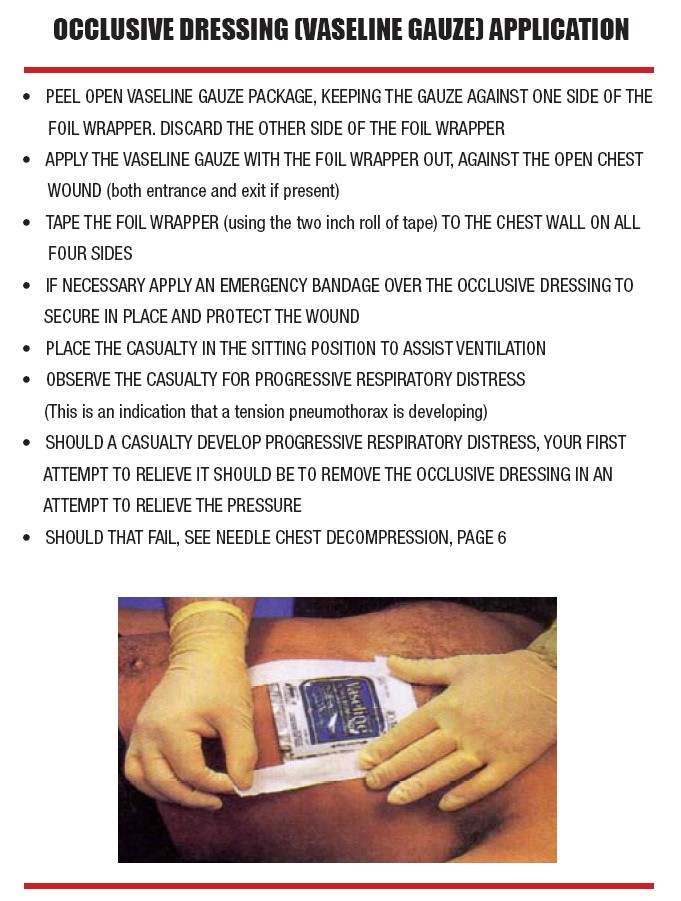
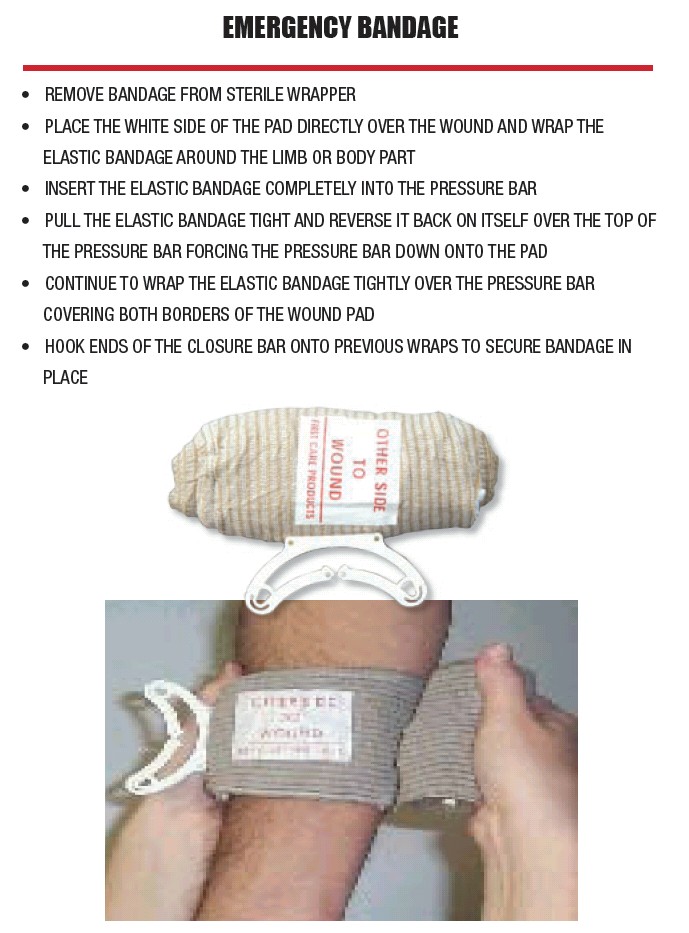
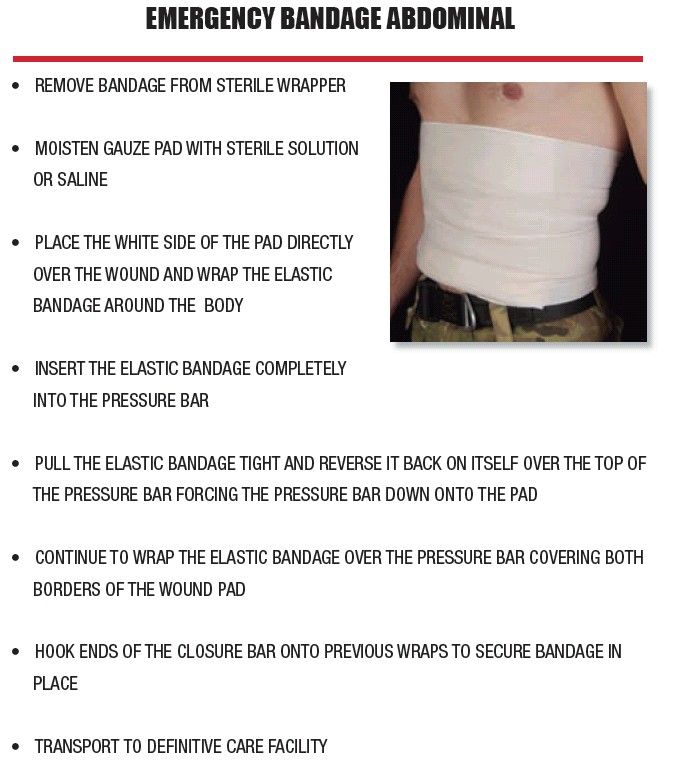
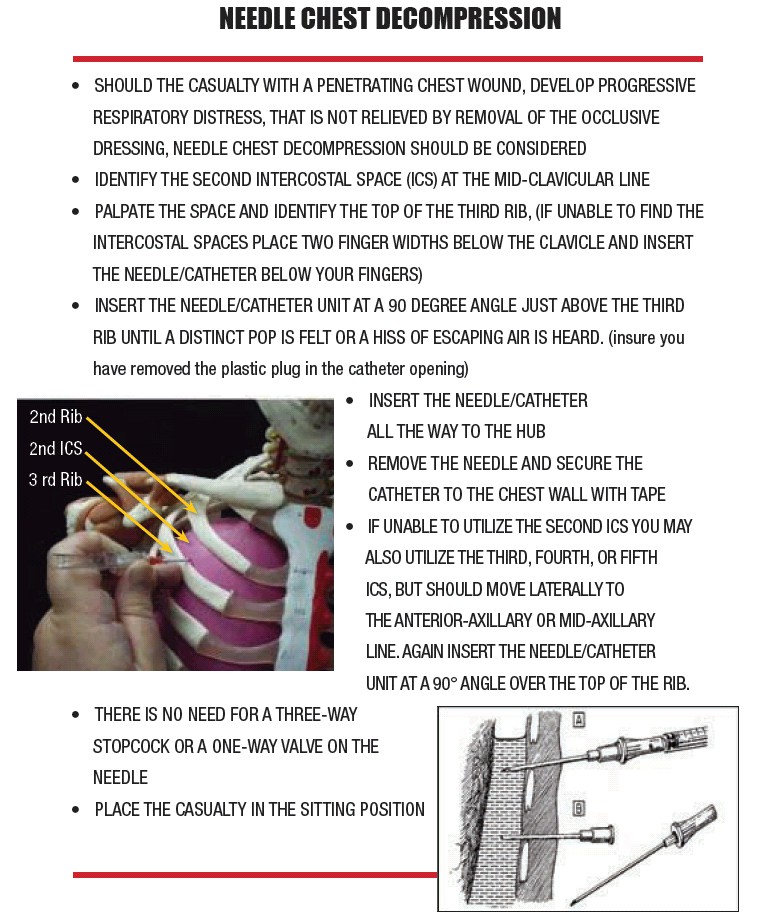
START THE BREATHING
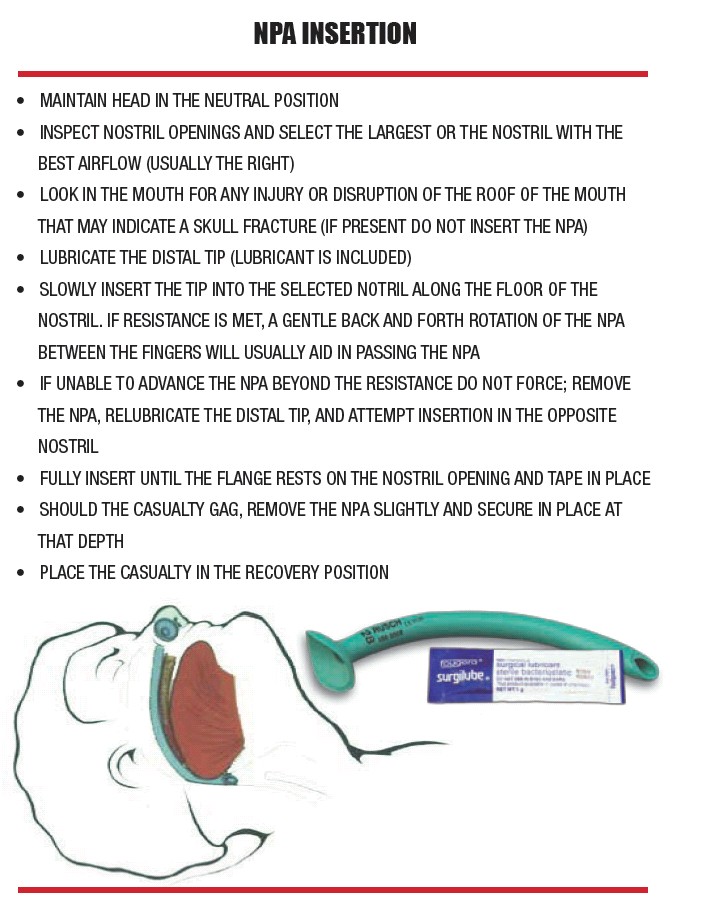
PROTECT THE WOUND
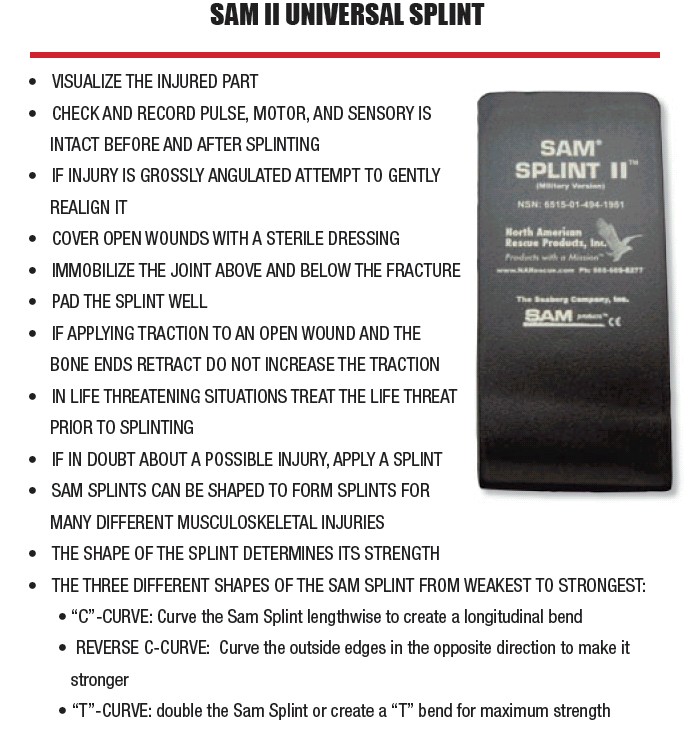
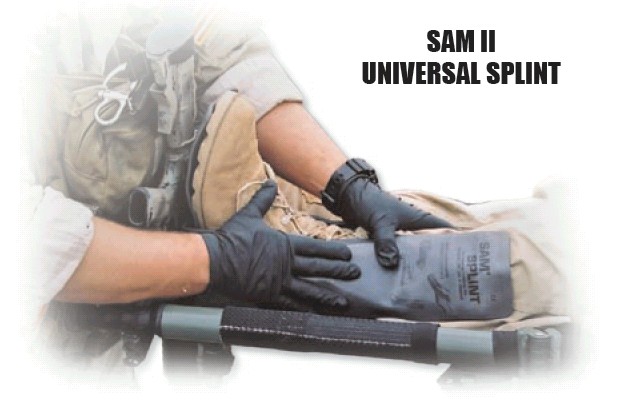
TREAT FOR SHOCK
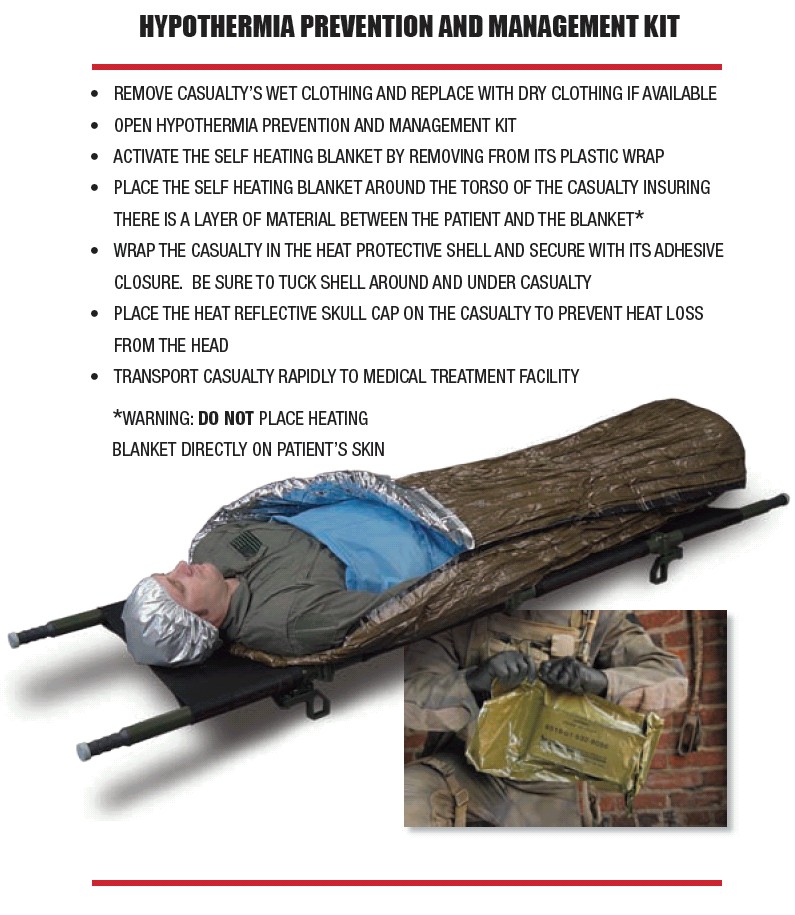
NEW! Kosmo lifeline: pulling your buddy out of the line of fire!
2. Attach to front of LBE
3. Ready to detach, open top flap and throw pouch to buddy to rescue you!
Kosmo in action!
4. Soldiers on-the-move with Kosmo lifelines ready
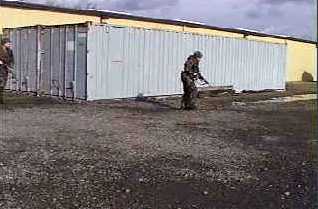
5. Enemy fire! Soldier goes down!

6. Soldiers return cover fire and throw smoke grenades (not shown for clarity)to mask wounded man

7. Wounded Soldier (or rescuer) throws Kosmo lifeline to buddies
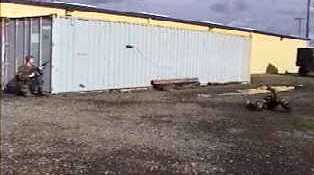
8. Rescuers grab bag end of Kosmo lifeline
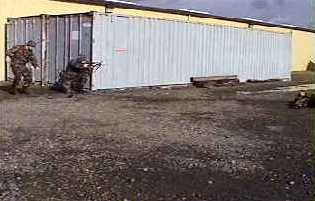
9. Wounded Soldier pulled to safety

10. Another Soldier assists to speed drag of wounded man to safety!
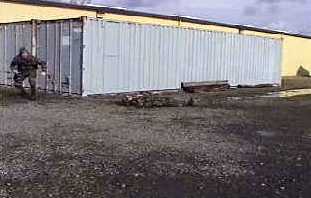
Details of the M3A CPL Desmond Doss Half-SKEDCO Combat LifeSaver Assault Pack
To honor the sacrifices of combat medics and lifesavers we name the M3A after Congressional Medal of Honor Winner, CPL Desmond T. Doss who was the first to win this award without even carrying a rifle!
The M3 bag is long overdue for a more organized replacement bag, why not incorporate a means to carry the lightweight half-SKED to insure a means at squad level exists to back-haul casualties and shuttle forward vital supplies using just one Soldier?
The Brigadier General William O. Darby UT 2000 All-Terrain All-purpose Cart Sled (ATACS)
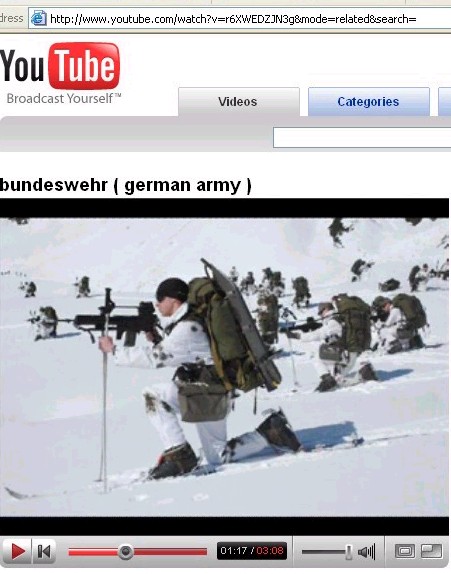
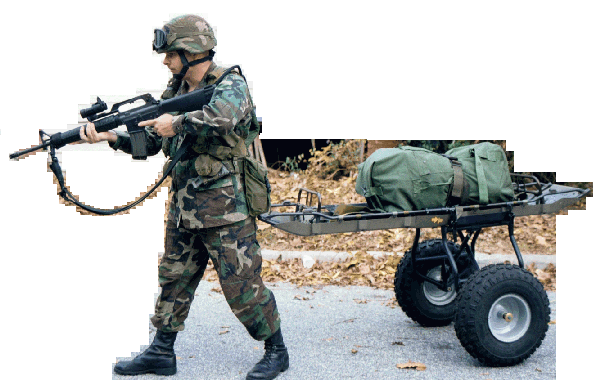
We can also deliver heavy machine guns, rockets, missiles and mortars the same way with the UT 2000 ATACs as snow sleds or better yet--attach all-terrain wheels for more efficient transport for longer distances after dismounting from helicopters.
Darby UT 2000 ATACS web page
Like SKEDCO, the UT 2000 ATACs has a NSN for ordering through the supply system or can be purchased direct for $759 each.
After the weapons and supplies have been shuttled forward, casualties can be slid by half-SKEDS back to the platoon's UT 2000 ATACS cart which then shuttles the wounded Soldier back to the Company CCP for transfer into either a HMMMV ambulance, a UH-60Q Blackhawk helicopter by full-size stretcher or a full-size SKEDCO for a hovering tagline extraction if the helo cannot land.
How to use the full-size SKED medevac system
NEW!
Quik-Clot Life-saving powder and gauze---must be in every CLS bag and in every Soldier's BDU leg trouser pocket going into combat!
DETAILS:
Remember how in WWII we used to pour a powder into wounds to sterilize them? Its still a good idea and its high time we have more than pressure to stop serious bleeding: Quik-Clot is an answer already saving 23 lives in Iraq.
CLS and MEDICS TO PATHFINDER SCHOOL ASAP
U.S. Army Center for Lessons Learned: Operation Just Cause Medical says the following about CLSers in Panama combat:
•Limited MEDEVAC assets make prioritizing casualties for evacuation and complete, accurate MEDEVAC requests essential.
•Aerial medical evacuation litter carousels hamper quick loading and leaves little room for ambulatory patients and supplies. For combat operations, when exact casualty conditions are not known, an empty MEDEVAC aircraft offers the best arrangement for casualty loads and speed.
•Units must have workable SOPs for controlling the equipment of medically evacuated Soldiers.
•Assault helicopters must be prepared to evacuate wounded from a landing zone (LZ) when they make a second or third lift.
•Medical personnel need to be trained in the requirements for helicopter landing zones and in guiding helicopters.
•A primary consideration for an aid station site is the availability of space for an LZ, particularly in MOUT."
"...aerial medical evacuation (MEDEVAC) was critical, but prioritization of casualties was extremely difficult due to incomplete MEDEVAC requests, contributing to delays.
Since medically trained personnel will have to arrange for helicopter MEDEVAC, they should be sent to U.S. Army PATHFINDER School at Fort Benning, Georgia as soon as possible to become PATHFINDER qualified. They will learn proper LZ selection and MEDEVAC procedures to be the Subject-Matter-Experts (SME)s in their units. This will speed the medical care wounded Soldiers receive and save lives.
TRAINING ON THE M113 GAVIN MEDEVAC VEHICLE
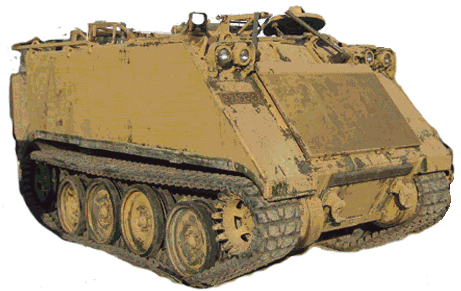
 www.youtube.com/v/Y116KsbTPiQ&hl
www.youtube.com/v/Y116KsbTPiQ&hl
The combat-proven M113A3 Gavin Armored Fighting Vehicle is a superb MEDEVAC transport that can dart in and recover wounded Soldier from enemy fire, without medical personnel becoming casualties, too. Every Medic and CLS should receive instruction on how to drive and use the various M113A3 Gavin AFVs being used for MEDEVAC and as a mobile treatment vehicleATV.The latter has detailed instructions that must be mastered.
The chain of command is about command--not idea formation communication--U.S. Army excellence and ideas for it must be considered, discussed and debated not pushed off into a corner and forgotten.
FEEDBACK!
An 18D Special Forces Medic writes in about the problem of IVs freezing in Afghanistan:
"I used to carry them in a claymore bag-under my clothes.
Worked OK.
You have to consider the ballistic effects on bullet striking IV bag 'Water charge'-next to body.
I still think there needs to an external heat source.
There are a couple proven techniques for keeping IVs warm:
1. Norweigian IV/Body heater-a little bulky-but works well
2. MRE heaters-used quite often. I actually have a paper on this somewhere
3. Reheater.com makes some reuseable heating packs
Tactical Tailor makes an insulated IV holder-I think it is called the PJ IV kit/bag"
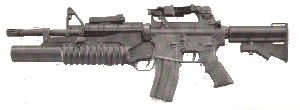 Return to Paratrooper 2000, click on M4 5.56mm Carbine with M203 40mm grenade launcher
Return to Paratrooper 2000, click on M4 5.56mm Carbine with M203 40mm grenade launcher
 Return to U.S. Army Airborne Equipment Shop
Return to U.S. Army Airborne Equipment Shop
